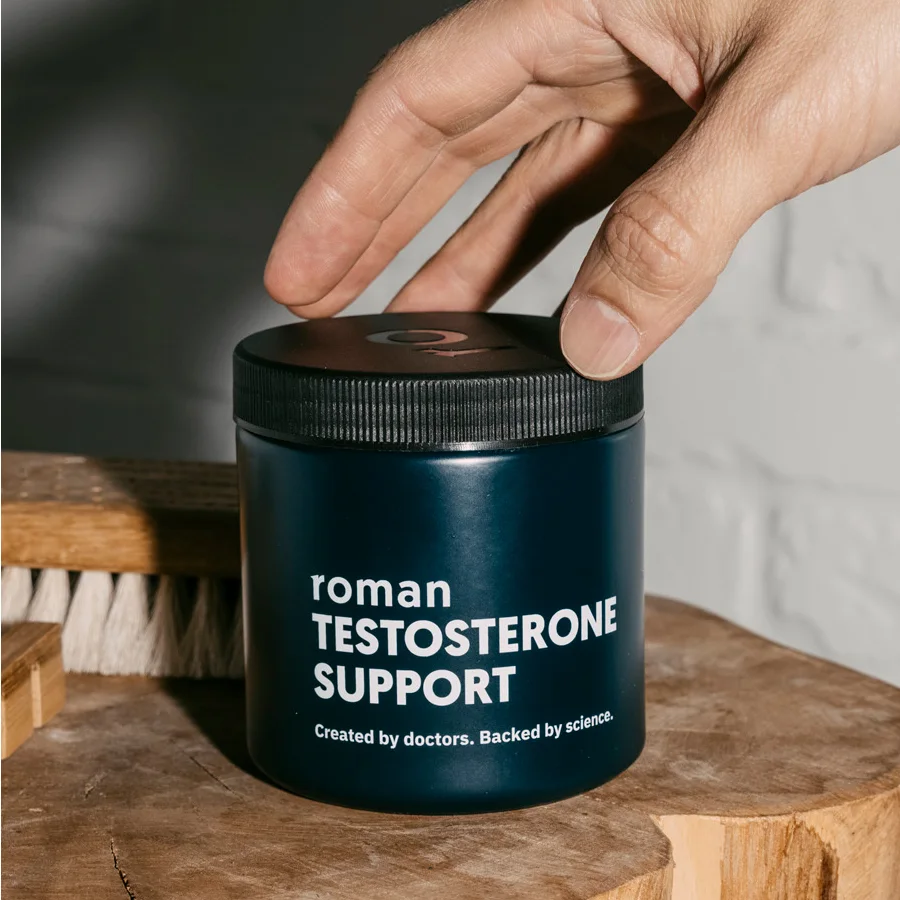Here's what we'll cover
Here's what we'll cover
Here's what we'll cover
For many reasons, pharmaceutical medication is not for everyone. Whether that’s due to health status, allergies, dangerous drug interactions, health conditions, or more, many turn to alternative medicine to treat their conditions.
So, what is saw palmetto? Does saw palmetto boost testosterone? The short answer is, we’re not sure. Some studies show promising results when it comes to boosting testosterone, but more research is needed. Studies on the impact of saw palmetto on symptoms of benign prostatic hyperplasia (BPH) don’t show any improvement. Continue reading to learn more about this culturally significant plant.
What is saw palmetto?
Saw palmetto, also known as Serenoa repens or American dwarf palm tree, is a plant native to the Southeastern United States. Historically, it was used to treat different health conditions, including for a variety of conditions, including diseases of the reproductive organs.
How does saw palmetto work?
Exactly how saw palmetto works is not fully understood. Some researchers believe it may inhibit 5-alpha-reductase (5a-R), an enzyme that converts testosterone to dihydrotestosterone (DHT). DHT is a male sex hormone that’s more potent than regular testosterone.
It has a wide range of functions in the body and plays an important role in biological male development, especially during puberty, including developing the penis, scrotum, testicles, and facial, body, and pubic hair. Unfortunately, it’s also been linked to male pattern baldness and benign prostatic hyperplasia (BPH), otherwise known as an enlarged prostate gland or benign prostatic hypertrophy. Reducing DHT levels is a way that some prescription BPH and hair loss medications (such as finasteride) work.
Finasteride Important Safety Information: Read more about serious warnings and safety info.
Does saw palmetto boost testosterone?
Testosterone, a primary biological male sex hormone, has a wide array of effects on the human body. It plays roles in maintaining your sex drive, bone mass, muscle mass, blood cell production, and sperm production. Levels of testosterone naturally decrease over time. Studies suggest that low testosterone (also called “low T”) affects 40% of men over 45, and 50% of men over 80. Understandably, many people are looking for ways to keep their testosterone up.
Several supplements on the market that contain saw palmetto claim to boost testosterone. Because it’s thought to block 5a-R, the enzyme that takes testosterone and turns it into DHT, logic follows that it might be able to increase testosterone levels. But how does this play out in real life, and can saw palmetto boost testosterone?
Saw palmetto is not proven to increase testosterone levels. Some studies show a decrease in DHT levels with saw palmetto supplementation, but no significant increase in testosterone.
If you’re concerned about low T, talk to your healthcare provider. They can test your hormone levels and determine what treatment would be right for you.
Saw palmetto and benign prostatic hyperplasia (BPH)
Saw palmetto is popular for treating the symptoms of benign prostatic hyperplasia, or BPH. People with BPH experience an unwelcome bundle of urinary problems, including straining, weak stream, retaining urine, frequent urination (especially at night), and the sudden need to urinate. Healthcare providers refer to these symptoms as lower urinary tract symptoms, or LUTS. The risk of BPH increases as men age, with rates as high as 70% in people in their 60s, and more than 80% in those over 70.
Despite its popularity, saw palmetto has not demonstrated in clinical trials that it works to treat BPH. A 2012 review of multiple randomized trials that included a total of over 5,000 patients with BPH showed that saw palmetto did not beat the placebo in urinary symptoms, urinary flow, or prostate size.
When it comes to treating symptoms of BPH, saw palmetto doesn’t seem to work. If you’re struggling with urinary symptoms or concerned about BPH, talk to your healthcare provider to see what tests and treatment options would be right for you.
Other benefits of saw palmetto
Saw palmetto is purported to benefit many other health conditions, including:
Prostate cancer: While some people believe that using saw palmetto will improve their prostate cancer, the research has not supported this. Studies do not show any improvement in prostate specific antigen (PSA) levels with saw palmetto use.
Prostatitis: Saw palmetto has not been shown to work in treating prostatitis (inflammation of the prostate that causes pain and burning urination).
Hair loss: Male pattern baldness affects millions of men in the United States. It gets more common with age, as 50% experience it by age 50, and 80% over age 70. Some small studies suggest that saw palmetto may increase hair growth and density. However, the scientific consensus is that there isn’t enough evidence to support its use.
Side effects of saw palmetto
Saw palmetto is generally considered safe, with only mild side effects like headaches and digestive symptoms. It doesn’t appear to interact with any other medications, but it’s primarily been studied in men. In women or children, the risks of saw palmetto are less clear.
Because of the hormonal effects of saw palmetto, don’t take saw palmetto while pregnant or breastfeeding.
As a dietary supplement, the FDA has not approved saw palmetto for any medicinal purpose. If you choose to take saw palmetto, be sure to tell your healthcare provider and follow their medical advice.
DISCLAIMER
If you have any medical questions or concerns, please talk to your healthcare provider. The articles on Health Guide are underpinned by peer-reviewed research and information drawn from medical societies and governmental agencies. However, they are not a substitute for professional medical advice, diagnosis, or treatment.
References
Anderson, M. L. (2014). Evaluation of Resettin® on serum hormone levels in sedentary males. Journal of the International Society of Sports Nutrition, 11,
doi: 10.1186/s12970-014-0043-x. Retrieved from https://jissn.biomedcentral.com/articles/10.1186/s12970-014-0043-x
Grammatikopoulou, M. G., Gkiouras, K., Papageorgiou, S. Τ., et al. (2020). Dietary factors and supplements influencing prostate specific-antigen (PSA) concentrations in men with prostate cancer and increased cancer risk: an evidence analysis review based on randomized controlled trials. Nutrients, 12 (10), 2985. doi:10.3390/nu12102985. Retrieved from https://www.ncbi.nlm.nih.gov/pmc/articles/PMC7600271/
Harman, S. M., Metter, E. J., Tobin, J. D., et al. (2001). Longitudinal effects of aging on serum total and free testosterone levels in healthy men. The Journal of Clinical Endocrinology & Metabolism, 86 (2), 724–731. doi: 10.1210/jcem.86.2.7219. Retrieved from https://www.ncbi.nlm.nih.gov/pubmed/11158037
Ho C. H., Sood T., & Zito P. M. (2022). Androgenetic alopecia. StatPearls . Retrieved on Feb. 21, 2023 from https://www.ncbi.nlm.nih.gov/books/NBK430924/
Kaplan, S. A., Volpe, M. A., & Te, A. E. (2004). A prospective, 1-year trial using saw palmetto versus finasteride in the treatment of Category III prostatitis/chronic pelvic pain syndrome. Journal of Urology, 171 (1), 284–288. doi:10.1097/01.ju.0000101487.83730.80. Retrieved from https://europepmc.org/article/med/14665895
Kwon, Y. (2019). Use of saw palmetto (Serenoa repens) extract for benign prostatic hyperplasia. Food Science and Biotechnology, 28 (6), 1599–1606. doi:10.1007/s10068-019-00605-9. Retrieved from https://pubmed.ncbi.nlm.nih.gov/31807332/
MacDonald, R., Tacklind, J. W., Rutks, I., et al. (2012). Serenoa repens monotherapy for benign prostatic hyperplasia (BPH): an updated Cochrane systematic review. BJU International, 109 (12), 1756–1761. doi:10.1111/j.1464-410X.2012.11172.x. Retrieved from https://pubmed.ncbi.nlm.nih.gov/22551330/
Murugusundram, S. (2009). Serenoa repens: Does it have any role in the management of androgenetic alopecia? Journal of Cutaneous and Aesthetic Surgery, 2 (1), 31–32. doi: 10.4103/0974-2077.53097. Retrieved from https://www.ncbi.nlm.nih.gov/pmc/articles/PMC2840915/
National Center for Complementary and Integrative Health. (2020). Saw Palmetto. Retrieved from https://nccih.nih.gov/health/palmetto/ataglance.htm
National Institutes of Health. (2020). Saw palmetto. Retrieved from https://www.nccih.nih.gov/health/saw-palmetto
Ng, M. & Baradhi, K. M. (2022). Benign prostatic hyperplasia. StatPearls . Retrieved on Feb. 21, 2023 from https://www.ncbi.nlm.nih.gov/books/NBK558920/
Prager, N., Bickett, K., French, N., et al. (2002). A Randomized, double-blind, placebo-controlled trial to determine the effectiveness of botanically derived inhibitors of 5-α-reductase in the treatment of androgenetic alopecia. The Journal of Alternative and Complementary Medicine, 8 (2), 143–152. doi: 10.1089/acm.2002.8.143. Retrieved from https://www.ncbi.nlm.nih.gov/pubmed/12006122
Sizar, O. & Schwartz, J. (2022). Hypogonadism. StatPearls . Retrieved on Feb. 21, 2023 from https://www.ncbi.nlm.nih.gov/books/NBK532933/
Wessagowit, V., Tangjaturonrusamee, C., Kootiratrakarn, T., et al. (2015). Treatment of male androgenetic alopecia with topical products containing Serenoa repensextract. Australasian Journal of Dermatology, 57 (3), e76–e82. doi: 10.1111/ajd.12352. Retrieved from https://www.ncbi.nlm.nih.gov/pubmed/26010505










